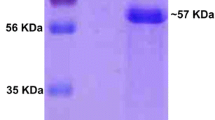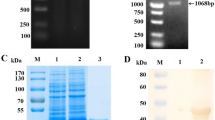Abstract
Leptospirosis is an important global zoonotic disease caused by pathogenic Leptospira spp. species. Swine leptospirosis has a major economic impact because pigs are sources of animal protein and by-products. The signs of swine leptospirosis are abortion, stillbirth, birth of weak or ill piglets, appearing 14–60 days after infection. The reference method for diagnosis of leptospirosis is the microscopic agglutination test (MAT), in which serum samples are reacted with live antigen suspensions of leptospiral serovars. However, MAT is laborious and time consuming as a diagnostic procedure when dealing with a large number of samples; therefore, efforts are being made to develop novel, sensitive, and specific diagnostic tests for leptospirosis. In this study, a recombinant LipL32 based on enzyme-linked immunosorbent assay (rLipL32/ELISA) was evaluated as a screening test for the detection of pathogenic leptospiral-specific antibodies. A total of 86 swine serum samples tested by MAT were used to develop rLipL32/ELISA. Compared to positive and negative sera tested by MAT, rLipL32/ELISA showed 100 % sensitivity, 85.1 % specificity, and 91.86 % accuracy. No positive reaction for other bacterial diseases (enzootic pneumonia and brucellosis) was observed. The rLipL32/ELISA reported in this study is a specific, sensitive, and convenient test for the detection of antibodies against swine leptospiral infection and can be used as a rapid screening test in epidemiological surveys.
Similar content being viewed by others
References
Adler B, de la Pena MA (2010) Leptospira and leptospirosis. Vet Microbiol 140:287–296
Adler B, Lo M, Seemann T et al (2011) Pathogenesis of leptospirosis: the influence of genomics. Vet Microbiol 153:73–81
Arimitsu Y, Kmety E, Ananyina Y et al (1994) Evaluation of the one-point microcapsule agglutination-test for diagnosis of leptospirosis. Bull World Health Organ 72:395–399
Bomfim MR, Ko A, Koury MC (2005) Evaluation of the recombinant LipL32 in enzyme-linked immunosorbent assay for the serodiagnosis of bovine leptospirosis. Vet Microbiol 109:89–94
Bradford MM (1976) A rapid and sensitive method for the quantitation of microgram quantities of protein utilizing the principle of protein-dye binding. Anal Biochem 72:248–254
Brandao AP, Camargo ED, da Silva ED et al (1998) Macroscopic agglutination test for rapid diagnosis of human leptospirosis. J Clin Microbiol 36:3138–3142
Cullen PA, Cordwell SJ, Bulach DM et al (2002) Global analysis of outer membrane proteins from Leptospira interrogans serovar Lai. Infect Immun 70:2311–2318
Cullen PA, Haake DA, Adler B (2004) Outer membrane proteins of pathogenic spirochetes. FEMS Microbiol Rev 28:291–318
Cumberland P, Everard CO, Levett PN (1999) Assessment of the efficacy of an IgM-elisa and microscopic agglutination test (MAT) in the diagnosis of acute leptospirosis. Am J Trop Med Hyg 61:731–734
Dey S, Mohan CM, Kumar TM et al (2004) Recombinant LipL32 antigen-based single serum dilution ELISA for detection of canine leptospirosis. Vet Microbiol 103:99–106
Effler PV, Domen HY, Bragg SL et al (2000) Evaluation of the indirect hemagglutination assay for diagnosis of acute leptospirosis in Hawaii. J Clin Microbiol 38:1081–1084
Faine S, Adler B, Bolin C, Perolat P (1999) Leptospira and leptospirosis. MedSci, Melbourne
Flannery B, Costa D, Carvalho FP et al (2001) Evaluation of recombinant Leptospira antigen-based enzyme-linked immunosorbent assays for the serodiagnosis of leptospirosis. J Clin Microbiol 39:3303–3310
Guerreiro H, Croda J, Flannery B et al (2001) Leptospiral proteins recognized during the humoral immune response to leptospirosis in humans. Infect Immun 69:4958–4968
Haake DA, Matsunaga J (2010) Leptospira: a spirochaete with a hybrid outer membrane. Mol Microbiol 77:805–814
Hoke DE, Egan S, Cullen PA et al (2008) LipL32 is an extracellular matrix-interacting protein of Leptospira spp. and Pseudoalteromonas tunicata. Infect Immun 76:2063–2069
Hull-Jackson C, Glass MB, Ari MD et al (2006) Evaluation of a commercial latex agglutination assay for serological diagnosis of leptospirosis. J Clin Microbiol 44:1853–1855
Laemmli UK (1970) Cleavage of structural proteins during the assembly of the head of bacteriophage T4. Nature 227:680–685
Levett PN (2001) Leptospirosis. Clin Microbiol Rev 14:296–326
Lin X, Zhao J, Qian J et al (2010) Identification of immunodominant B- and T-cell combined epitopes in outer membrane lipoproteins LipL32 and LipL21 of Leptospira interrogans. Clin Vaccin Immunol 17:778–783
Mariya R, Chaudhary P, Kumar AA et al (2006) Evaluation of a recombinant LipL41 antigen of Leptospira interrogans serovar canicola in ELISA for serodiagnosis of bovine leptospirosis. Comp Immunol Microbiol Infect Dis 29:269–277
Merien F, Truccolo J, Baranton G et al (2000) Identification of a 36-kDa fibronectin-binding protein expressed by a virulent variant of Leptospira interrogans serovar icterohaemorrhagiae. FEMS Microbiol Lett 185:17–22
Rajeev S, Berghaus RD, Overton MW et al (2010) Comparison of fluorescent antibody and microscopic agglutination testing for Leptospira in pregnant and nonpregnant cows. J Vet Diagn Invest 22:51–54
Smits HL, Eapen CK, Sugathan S et al (2001) Lateral-flow assay for rapid serodiagnosis of human leptospirosis. Clin Diagn Lab Immunol 8:166–169
Wang Z, Jin L, Wegrzyn A (2007) Leptospirosis vaccines. Microb Cell Fact 6:39
Wasinski B, Pejsak Z (2010) Occurrence of leptospiral infections in swine population in Poland evaluated by ELISA and microscopic agglutination test. Pol J Vet Sci 13:695–699
Wolff JW (1954) The laboratory diagnosis of leptospirosis. Charles C Thomas, Springfield
Acknowledgments
This study was supported by FAPERGS Programa Pesquisador Gaúcho—Edital PqG No. 06/2010, Grant 1010724.
Conflict of interest
No competing financial interests exist.
Author information
Authors and Affiliations
Corresponding author
Rights and permissions
About this article
Cite this article
Hartleben, C.P., Leal, F.M.A., Monte, L.G. et al. Serological Analysis by Enzyme-Linked Immunosorbent Assay Using Recombinant Antigen LipL32 for the Diagnosis of Swine Leptospirosis. Curr Microbiol 66, 106–109 (2013). https://doi.org/10.1007/s00284-012-0237-x
Received:
Accepted:
Published:
Issue Date:
DOI: https://doi.org/10.1007/s00284-012-0237-x




